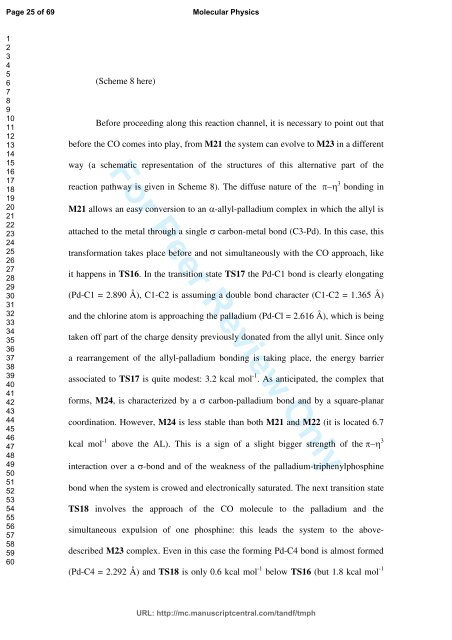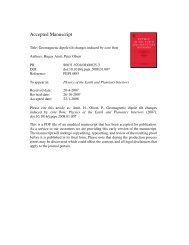For Peer Review Only - TARA
For Peer Review Only - TARA
For Peer Review Only - TARA
You also want an ePaper? Increase the reach of your titles
YUMPU automatically turns print PDFs into web optimized ePapers that Google loves.
Page 25 of 69<br />
Molecular Physics<br />
1<br />
2<br />
3<br />
4<br />
5<br />
6<br />
7<br />
8<br />
9<br />
10<br />
11<br />
12<br />
13<br />
14<br />
15<br />
16<br />
17<br />
18<br />
19<br />
20<br />
21<br />
22<br />
23<br />
24<br />
25<br />
26<br />
27<br />
28<br />
29<br />
30<br />
31<br />
32<br />
33<br />
34<br />
35<br />
36<br />
37<br />
38<br />
39<br />
40<br />
41<br />
42<br />
43<br />
44<br />
45<br />
46<br />
47<br />
48<br />
49<br />
50<br />
51<br />
52<br />
53<br />
54<br />
55<br />
56<br />
57<br />
58<br />
59<br />
60<br />
(Scheme 8 here)<br />
Before proceeding along this reaction channel, it is necessary to point out that<br />
before the CO comes into play, from M21 the system can evolve to M23 in a different<br />
<strong>For</strong> <strong>Peer</strong> <strong>Review</strong> <strong>Only</strong><br />
way (a schematic representation of the structures of this alternative part of the<br />
reaction pathway is given in Scheme 8). The diffuse nature of the π−η 3 bonding in<br />
M21 allows an easy conversion to an α-allyl-palladium complex in which the allyl is<br />
attached to the metal through a single σ carbon-metal bond (C3-Pd). In this case, this<br />
transformation takes place before and not simultaneously with the CO approach, like<br />
it happens in TS16. In the transition state TS17 the Pd-C1 bond is clearly elongating<br />
(Pd-C1 = 2.890 Å), C1-C2 is assuming a double bond character (C1-C2 = 1.365 Å)<br />
and the chlorine atom is approaching the palladium (Pd-Cl = 2.616 Å), which is being<br />
taken off part of the charge density previously donated from the allyl unit. Since only<br />
a rearrangement of the allyl-palladium bonding is taking place, the energy barrier<br />
associated to TS17 is quite modest: 3.2 kcal mol -1 . As anticipated, the complex that<br />
forms, M24, is characterized by a σ carbon-palladium bond and by a square-planar<br />
coordination. However, M24 is less stable than both M21 and M22 (it is located 6.7<br />
kcal mol -1 above the AL). This is a sign of a slight bigger strength of the π−η 3<br />
interaction over a σ-bond and of the weakness of the palladium-triphenylphosphine<br />
bond when the system is crowed and electronically saturated. The next transition state<br />
TS18 involves the approach of the CO molecule to the palladium and the<br />
simultaneous expulsion of one phosphine: this leads the system to the abovedescribed<br />
M23 complex. Even in this case the forming Pd-C4 bond is almost formed<br />
(Pd-C4 = 2.292 Å) and TS18 is only 0.6 kcal mol -1 below TS16 (but 1.8 kcal mol -1<br />
URL: http://mc.manuscriptcentral.com/tandf/tmph
















